文章目录
LZW算法原理
LZW编码
编码算法的思想
步骤1:将词典初始化为包含所有可能的单字符,当前前缀P初始化为空。
步骤2:当前字符C=字符流中的下一个字符。
步骤3:判断P+C是否在词典中:
(1)如果是,则用C扩展P,即P=P+C,返回到步骤2.
(2)如果否,则 输出与当前前缀P相对应的码字W;将P+C添加到词典中;令P=C,并返回到步骤2.
数据结构分析
| 尾缀字符 | suffix |
| 母节点 | parent |
| 第一个孩子节点 | firstchild |
| 下一个兄弟节点 | nextsibling |
树用数组表示,数组下标用pointer表示,dict[pointer]表示一个节点:
dict[pointer].suffix
dict[pointer].parent
dict[pointer].firstchild
dict[pointer].nextsibling
struct {
int suffix;
int parent, firstchild, nextsibling;
} dictionary[MAX_CODE+1];
int next_code;
int d_stack[MAX_CODE]; // stack for decoding a phrase
主要功能模块
初始化词典
void InitDictionary( void){//初始化词典,将0-255根节点初始化
int i;
for( i=0; i<256; i++){
dictionary[i].suffix = i;//尾缀字符
dictionary[i].parent = -1;//母节点初始化为空
dictionary[i].firstchild = -1;//子节点初始化为空
dictionary[i].nextsibling = i+1;//下一个兄弟节点
}
dictionary[255].nextsibling = -1;//最后一个节点无下一个兄弟
next_code = 256;//新词条编码为256
}
查找词典中是否有字符串
将当前字符依次与当前前缀的孩子节点进行比较,相同时说明词典中有该字符串,否则说明词典中没有该字符串,返回-1。
int InDictionary( int character, int string_code){//查找词典中是否有字符串
int sibling;
if( 0>string_code) return character;//string_code==-1,当前词条无前缀,为单个字符,初始化后已经在词典中,返回此字符
sibling = dictionary[string_code].firstchild;//如果不是单个字符,找当前前缀的第一个孩子节点
while( -1<sibling){
if( character == dictionary[sibling].suffix) return sibling;//如果此孩子节点的尾缀字符等于character,则当前词条在词典中,返回此孩子节点
sibling = dictionary[sibling].nextsibling;//否则,找当前前缀的下一个孩子节点
}
return -1;//没有找到,返回-1
}
将新串加入词典
将新串加入词典,则需要添加新节点,设置新节点的suffix,parent,nextsibling,firstchild,另外还需建立新节点与当前前缀其他孩子节点的关系。
void AddToDictionary( int character, int string_code){//将新串加入词典
int firstsibling, nextsibling;
if( 0>string_code) return;//string_code==-1,当前词条无前缀,为单个字符,初始化后已经在词典中
dictionary[next_code].suffix = character;//添加新节点dictionary[next_code],其尾缀字符为character
dictionary[next_code].parent = string_code;//新节点的母节点为string_code
dictionary[next_code].nextsibling = -1;//新节点还没有下一个兄弟
dictionary[next_code].firstchild = -1;//新节点还没有孩子
firstsibling = dictionary[string_code].firstchild;//firstsibling为当前前缀的第一个孩子
if( -1<firstsibling){ // 如果当前前缀有孩子
nextsibling = firstsibling;
while( -1<dictionary[nextsibling].nextsibling ) //只要nextsibling还有下一个兄弟
nextsibling = dictionary[nextsibling].nextsibling;//让nextsibling替换为它的下一个兄弟,这样可以找到当前前缀的最后一个孩子
dictionary[nextsibling].nextsibling = next_code;//当前前缀的最后一个孩子的下一个兄弟为新节点
}else{// 当前前缀无孩子,则新节点为它的第一个孩子
dictionary[string_code].firstchild = next_code;
}
next_code ++;//为下一个新词条所用
}
编码
如果当前字符串在词典中,将当前字符串设为前缀。如果当前字符串不在词典中,将当前字符串写入词典中,输出当前字符串前缀对应的码字,当前字符设为前缀。详见代码注释。
void LZWEncode( FILE *fp, BITFILE *bf){//LZW编码
int character;//当前字符C
int string_code;//当前前缀P
int index;//定义索引
unsigned long file_length;//定义文件长度
fseek( fp, 0, SEEK_END);//将指针置于文件末尾
file_length = ftell( fp);//得到当前文件长度
fseek( fp, 0, SEEK_SET);//将指针移回文件开始
BitsOutput( bf, file_length, 4*8);
InitDictionary();//初始化词典
string_code = -1;//初始化后的词典为单个字符,无前缀
while( EOF!=(character=fgetc( fp))){//EOF:END OF FILE,每次从文件中读取一个字符,直到文件的最后一个字符
index = InDictionary( character, string_code);//查找当前字符串是否在词典中,如果不在,则index=-1,如果在,则返回的是当前字符串的后缀(单个字符时为该字符),index>=0
if( 0<=index){ // string+character in dictionary 如果当前字符串在词典中
string_code = index;//将当前字符串设为前缀
}else{ // string+character not in dictionary 如果当前字符串不在词典中
output( bf, string_code);//输出当前前缀对应的码字
if( MAX_CODE > next_code){ // free space in dictionary,只要未超过词典容限
// add string+character to dictionary
AddToDictionary( character, string_code);//将当前字符串加入到词典中
}
string_code = character;//将当前字符C设为前缀P
}
}
output( bf, string_code);//最后一个前缀无下一个字符,将其对应的码字输出
}
LZW解码
解码算法的思想
步骤1:在开始译码时词典包含所有可能的前缀根。
步骤2:令CW=码字流中的第一个码字
步骤3:输出CW对应的字符到字符流
步骤4:先前码字PW=当前码字CW
步骤5:当前码字CW等于码字流中的下一个码字
步骤5:判断CW是否在词典中
(1)如果是,将CW对应的字符串输出到字符流中,当前前缀P=PW对应的字符串,当前字符C=CW对应字符串中的第一个字符,将P+C添加到词典中,先前码字PW=当前码字CW;
(2)如果否,即如果CW不在词典中,说明该词条刚写入词典就被使用,该字符串的第一个字符等于最后一个字符,当前前缀P=PW对应的字符串,当前字符C=PW对应字符串中的第一个字符,将P+C添加到词典中,将P+C输出到字符流中,先前码字PW=当前码字CW;
步骤7:判断码字流中是否还有码字要译。
(1)如果”是”,就返回步骤4。
(2)如果”否”,结束。
解码
当前码字不在词典中的情况:说明一个词条刚写入词典就被使用,举例:
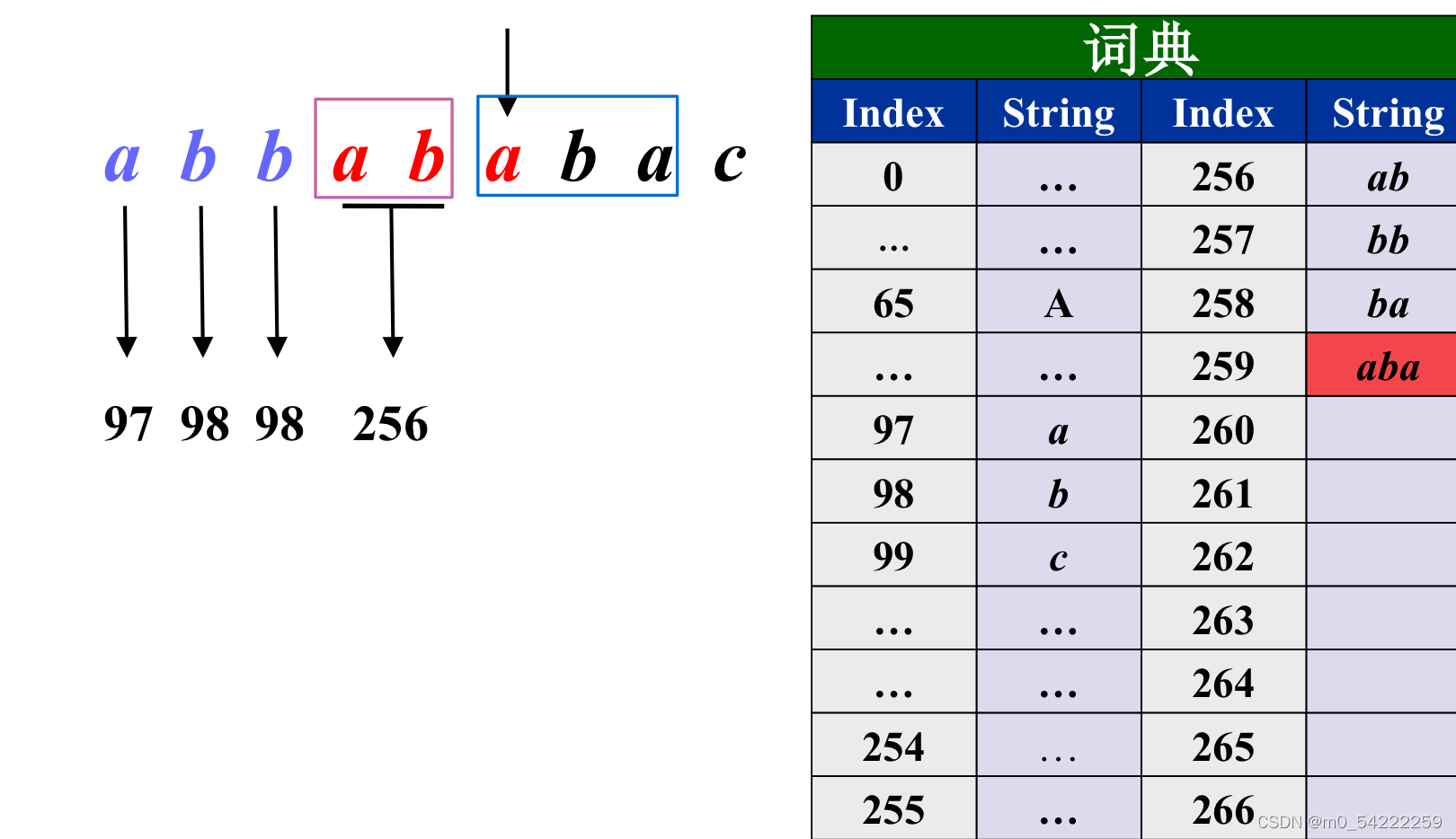
“aba”被写入词典后,输出“ab”对应的码字,'“a”作为新的前缀,判断“ab”在词典中,则“ab”作为新的前缀,判断"aba"在词典中,则刚写入词典的“aba”对应的码字被输出。但在解码端,收到码字就开始解码,解码到256时,"ba“刚被写入词典中,此时词典中还未写入”aba“对应的码字。只有编码端刚写入的词条就被使用时才会发生这种情况,而只有该字符串的第一个字符等于最后一个字符时,这种情况才会发生。因此,当前码字不在词典中时,说明当前码字对应的字符串为先前码字对应的字符串+先前码字对应字符串的第一个字符。
LZWDecode
首先初始化词典,如果当前码字不在词典中,将character赋给d_stack[0],并在d_stack[]中存储先前码字对应的字符串(倒序存放),如果当前码字在词典中,在d_stack[]中存储当前码字对应字符串(倒序存放),则可以得到先前码字或当前码字的第一个字符d_stack[phrase_length-1]。当前码字不在词典中时,新词条为当前前缀+当前前缀的第一个字符,将先前码字对应的字符串+先前码字对应字符串的第一个字符输出到字符流中。当前码字在词典中时,将当前码字对应的字符串输出到字符流中,新词条为当前前缀+当前字符串的第一个字符。最后将当前码字设为先前码字。
void LZWDecode( BITFILE *bf, FILE *fp){//LZW解码
//需填充
int character;//定义当前字符
int new_code, last_code;//定义当前码字和先前码字
int phrase_length;//定义字符串长度
unsigned long file_length;//定义输出文件长度
file_length = BitsInput(bf, 4 * 8);//解码后文件的大小
if (-1 == file_length)
{
file_length = 0;
}
InitDictionary();//初始化词典,使在开始译码时词典包含所有可能的前缀根
last_code = -1;//译码前无先前码字
while (file_length > 0)//file_length > 0表示解码未完成,继续解码
{
new_code = input(bf);//从输入文件中读出一个码字,为当前码字
if (new_code >= next_code)//如果当前码字不在词典中
{
d_stack[0] = character;//先将character赋给d_stack[0]
phrase_length = DecodeString(1, last_code);//从d_stack[1]开始存储先前码字对应的字符串,
//d_stack[1]存储的是先前码字对应的字符串的最后一个字符,phrase_length为先前码字对应字符串的长度+1
//d_stack[phrase_length-1]存储的是先前码字对应字符串的第一个字符
}
else//如果当前码字在词典中
{
phrase_length = DecodeString(0, new_code);//从d_stack[0]开始存储当前码字对应的字符串,
//d_stack[0]存储的是当前码字对应字符串的最后一个字符,phrase_length为当前码字对应字符串的长度
// d_stack[phrase_length-1]存储的是当前码字对应字符串的第一个字符
}
character = d_stack[phrase_length-1];
//当前码字不在词典中时,character为先前码字对应字符串的第一个字符
//当前码字在词典中时,character为当前码字对应字符串的第一个字符
while (0 < phrase_length)//循环,直到d_stack[]全部输出
{
phrase_length--;
fputc(d_stack[phrase_length],fp);//d_stack[]为倒序存放,这样可以正序输出
//当前码字不在词典中时,将先前码字对应的字符串+先前码字对应字符串的第一个字符输出到字符流中
//当前码字在词典中时,将当前码字对应的字符串输出到字符流中
file_length--;
}
if (MAX_CODE > next_code)//未超过词典容限时
{
AddToDictionary(character, last_code);
//当前码字不在词典中时,新词条为当前前缀+当前前缀的第一个字符
//当前码字在词典中时,新词条为当前前缀+当前字符串的第一个字符
}
last_code = new_code;//将当前码字设为先前码字
}
}
DecodeString
int DecodeString( int start, int code){
//需填充
int count;
count = start;
while (0 <= code)//从最后一个节点开始,向上搜索并存入stack[]中,直到找到最后一个母节点
{
d_stack[count] = dictionary[code].suffix;
code = dictionary[code].parent;
count++;//记录次数
}
return count;//count=code对应字符串的长度+start
}
调试程序
代码补充完整后,我们首先用课件上的数据进行实验。新建文本文件test1.txt,内容为“abbababac”
编码后的词典应为:
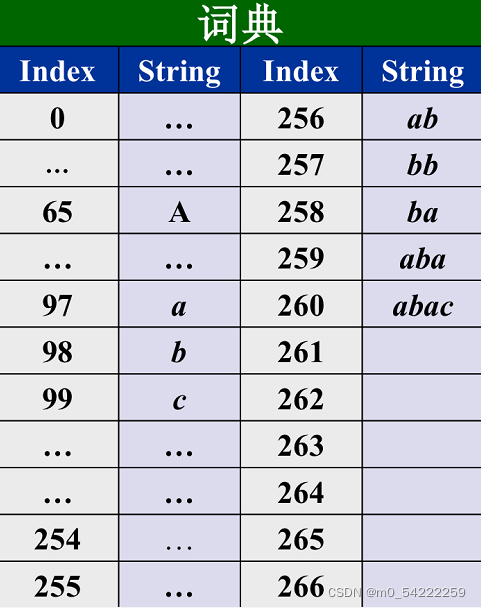
设置命令参数,待编码文件为test1.txt,编码后文件为test1.dat,dat文件多为程序使用的数据,它只是开发者为了清楚文件的意思而自己定义的。
编码

调用PrintDictionary()函数来输出256之后的词典
void PrintDictionary( void){
int n;
int count;
for( n=256; n<next_code; n++){
count = DecodeString( 0, n);
printf( "%4d->", n);
while( 0<count--) printf("%c", (char)(d_stack[count]));
printf( "\n");
}
}
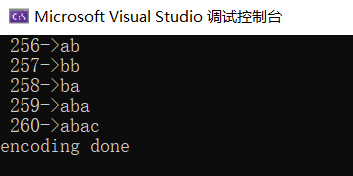
得到的结果和理论相同。编码正确。
解码
接下来,我们用编码后得到的test1.dat进行解码,设置命令参数:
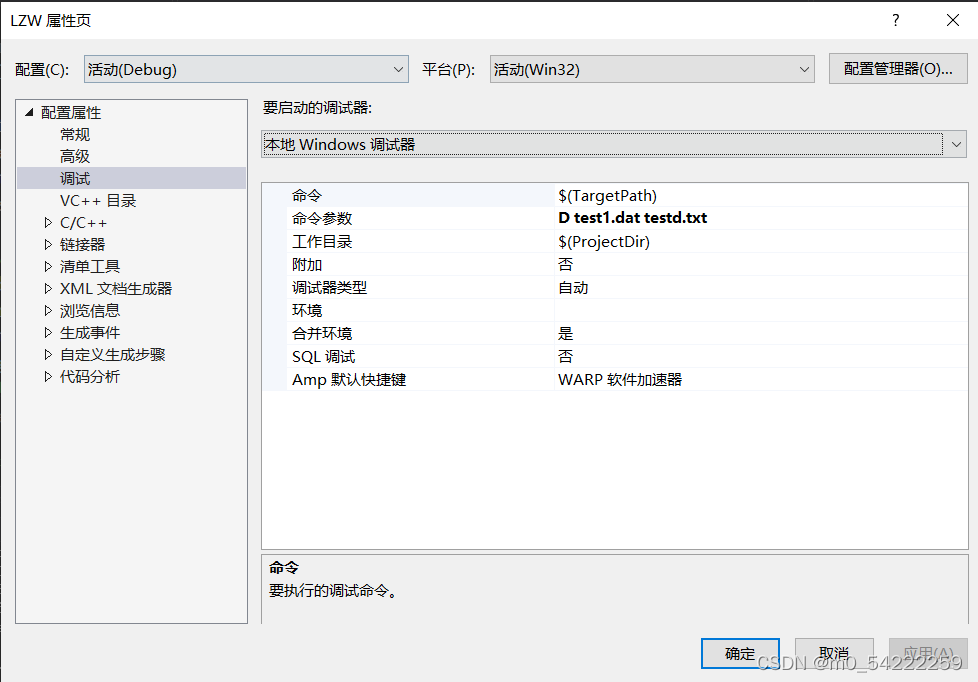
运行程序后,得到解码后的文件testd.txt,内容与编码前的内容相同。说明解码正确。
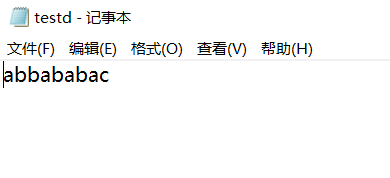
压缩效率分析
十种不同格式文件的压缩效率
准备十种不同格式的文件,使用LZW编码器进行压缩得到输出的压缩比特流文件。

压缩后的文件:
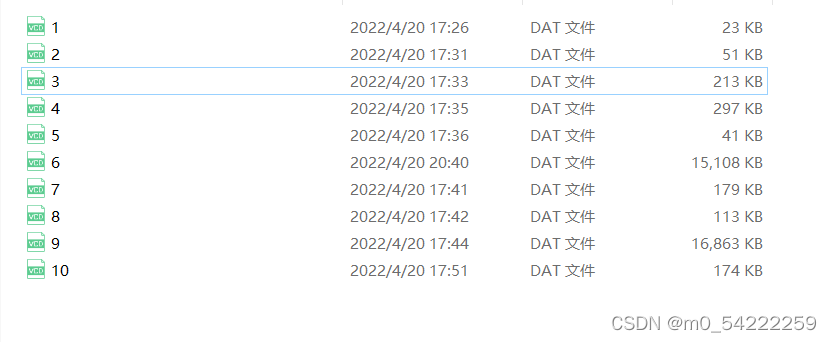
将压缩后文件的格式,数据量,压缩后文件的数据量,以及编码词典总数写入表格中进行比较:
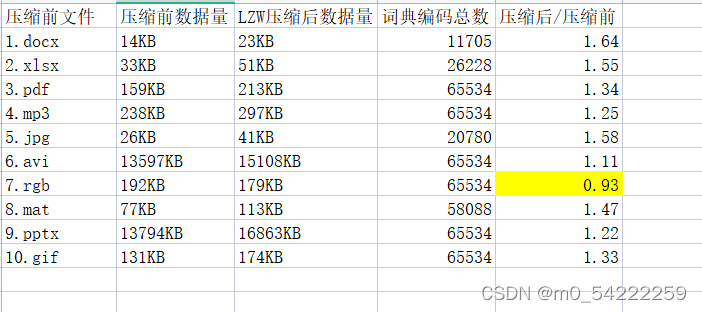
更改词典总数上限后的编码效率
不同格式的文件经LZW编码器压缩后,压缩效率有很大的不同。仅有7.rgb经过LZW编码后数据量减小了,其余九个文件经LZW压缩编码后数据量反而上升。本次实验词典总数上限为65535,其中第3,4,6,9,10个文件词典编码总数均已达到上限,因此我们增大词典总数上限,将MAXCODE设为200000,继续进行LZW编码,得到如下结果:
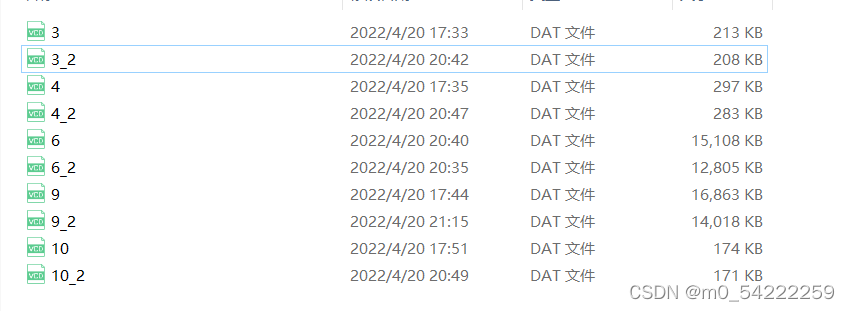

增大词典总数上限后,数据量较第一次压缩后的结果更小了,但除了6.avi数据量较原文件有所减小,其他文件压缩后的数据量还是大于原文件。对于词典编码总数仍达到上限的文件,可能是MAXCODE的值仍旧太小,数据量过大,导致压缩算法未充分利用。词典编码总数未达到上界,压缩后数据量大于原文件的,可能是文件中重复字符的概率小,LZW压缩算法不能发挥优势。
字符重复率很高的文本文档
新建一个文本文档,内容为重复率很高的字符
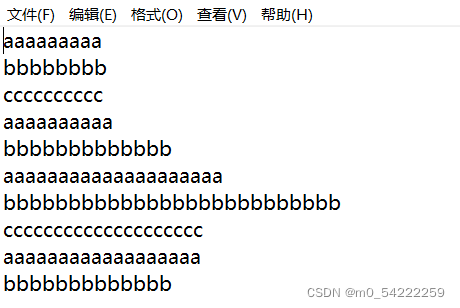
使用LZW编码器进行压缩后,数据量有了很明显的减小

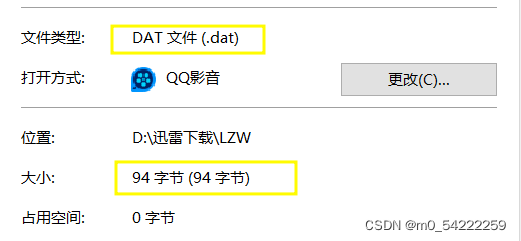
LZW算法的优缺点
由此可见,字符串重复率低时,压缩效率受到很大的影响,这是LZW算法的一大局限。它的优点是只需一遍扫描,具有自适应的特点,算法简单,便于快速实现。
程序代码
bitio.h
/*
* Declaration for bitwise IO
*
* vim: ts=4 sw=4 cindent
*/
#ifndef __BITIO__
#define __BITIO__
#include <stdio.h>
typedef struct{
FILE *fp;
unsigned char mask;
int rack;
}BITFILE;
BITFILE *OpenBitFileInput( char *filename);
BITFILE *OpenBitFileOutput( char *filename);
void CloseBitFileInput( BITFILE *bf);
void CloseBitFileOutput( BITFILE *bf);
int BitInput( BITFILE *bf);
unsigned long BitsInput( BITFILE *bf, int count);
void BitOutput( BITFILE *bf, int bit);
void BitsOutput( BITFILE *bf, unsigned long code, int count);
#endif // __BITIO__
bitio.c
/*
* Definitions for bitwise IO
*
* vim: ts=4 sw=4 cindent
*/
#include <stdlib.h>
#include <stdio.h>
#include "bitio.h"
BITFILE *OpenBitFileInput( char *filename){
BITFILE *bf;
bf = (BITFILE *)malloc( sizeof(BITFILE));
if( NULL == bf) return NULL;
if( NULL == filename) bf->fp = stdin;
else bf->fp = fopen( filename, "rb");
if( NULL == bf->fp) return NULL;
bf->mask = 0x80;
bf->rack = 0;
return bf;
}
BITFILE *OpenBitFileOutput( char *filename){
BITFILE *bf;
bf = (BITFILE *)malloc( sizeof(BITFILE));
if( NULL == bf) return NULL;
if( NULL == filename) bf->fp = stdout;
else bf->fp = fopen( filename, "wb");
if( NULL == bf->fp) return NULL;
bf->mask = 0x80;
bf->rack = 0;
return bf;
}
void CloseBitFileInput( BITFILE *bf){
fclose( bf->fp);
free( bf);
}
void CloseBitFileOutput( BITFILE *bf){
// Output the remaining bits
if( 0x80 != bf->mask) fputc( bf->rack, bf->fp);
fclose( bf->fp);
free( bf);
}
int BitInput( BITFILE *bf){
int value;
if( 0x80 == bf->mask){
bf->rack = fgetc( bf->fp);
if( EOF == bf->rack){
fprintf(stderr, "Read after the end of file reached\n");
exit( -1);
}
}
value = bf->mask & bf->rack;
bf->mask >>= 1;
if( 0==bf->mask) bf->mask = 0x80;
return( (0==value)?0:1);
}
unsigned long BitsInput( BITFILE *bf, int count){
unsigned long mask;
unsigned long value;
mask = 1L << (count-1);
value = 0L;
while( 0!=mask){
if( 1 == BitInput( bf))
value |= mask;
mask >>= 1;
}
return value;
}
void BitOutput( BITFILE *bf, int bit){
if( 0 != bit) bf->rack |= bf->mask;
bf->mask >>= 1;
if( 0 == bf->mask){ // eight bits in rack
fputc( bf->rack, bf->fp);
bf->rack = 0;
bf->mask = 0x80;
}
}
void BitsOutput( BITFILE *bf, unsigned long code, int count){
unsigned long mask;
mask = 1L << (count-1);
while( 0 != mask){
BitOutput( bf, (int)(0==(code&mask)?0:1));
mask >>= 1;
}
}
#if 0
int main( int argc, char **argv){
BITFILE *bfi, *bfo;
int bit;
int count = 0;
if( 1<argc){
if( NULL==OpenBitFileInput( bfi, argv[1])){
fprintf( stderr, "fail open the file\n");
return -1;
}
}else{
if( NULL==OpenBitFileInput( bfi, NULL)){
fprintf( stderr, "fail open stdin\n");
return -2;
}
}
if( 2<argc){
if( NULL==OpenBitFileOutput( bfo, argv[2])){
fprintf( stderr, "fail open file for output\n");
return -3;
}
}else{
if( NULL==OpenBitFileOutput( bfo, NULL)){
fprintf( stderr, "fail open stdout\n");
return -4;
}
}
while( 1){
bit = BitInput( bfi);
fprintf( stderr, "%d", bit);
count ++;
if( 0==(count&7))fprintf( stderr, " ");
BitOutput( bfo, bit);
}
return 0;
}
#endif
lzw.c
/*
* Definition for LZW coding
*
* vim: ts=4 sw=4 cindent nowrap
*/
#include <stdlib.h>
#include <stdio.h>
#include "bitio.h"
#define MAX_CODE 65535
//#define MAX_CODE 200000
struct {
int suffix;
int parent, firstchild, nextsibling;
} dictionary[MAX_CODE+1];
int next_code;
int d_stack[MAX_CODE]; // stack for decoding a phrase
#define input(f) ((int)BitsInput( f, 16))
#define output(f, x) BitsOutput( f, (unsigned long)(x), 16)
int DecodeString( int start, int code);
void InitDictionary( void);
void PrintDictionary( void){
int n;
int count;
for( n=256; n<next_code; n++){
count = DecodeString( 0, n);
printf( "%4d->", n);
while( 0<count--) printf("%c", (char)(d_stack[count]));
printf( "\n");
}
}
int DecodeString( int start, int code){
//需填充
int count;
count = start;
while (0 <= code)//从最后一个节点开始,向上搜索并存入stack[]中,直到找到最后一个母节点
{
d_stack[count] = dictionary[code].suffix;
code = dictionary[code].parent;
count++;//记录次数
}
return count;//count=code对应字符串的长度+start
}
void InitDictionary( void){//初始化词典,将0-255根节点初始化
int i;
for( i=0; i<256; i++){
dictionary[i].suffix = i;//尾缀字符
dictionary[i].parent = -1;//母节点初始化为空
dictionary[i].firstchild = -1;//子节点初始化为空
dictionary[i].nextsibling = i+1;//下一个兄弟节点
}
dictionary[255].nextsibling = -1;//最后一个节点无下一个兄弟
next_code = 256;//新词条编码为256
}
/*
* Input: string represented by string_code in dictionary,
* Output: the index of character+string in the dictionary
* index = -1 if not found
*/
int InDictionary( int character, int string_code){//查找词典中是否有字符串
int sibling;
if( 0>string_code) return character;//string_code==-1,当前词条无前缀,为单个字符,初始化后已经在词典中,返回此字符
sibling = dictionary[string_code].firstchild;//如果不是单个字符,找当前前缀的第一个孩子节点
while( -1<sibling){
if( character == dictionary[sibling].suffix) return sibling;//如果此孩子节点的尾缀字符等于character,则当前词条在词典中,返回此孩子节点
sibling = dictionary[sibling].nextsibling;//否则,找当前前缀的下一个孩子节点
}
return -1;//没有找到,返回-1
}
void AddToDictionary( int character, int string_code){//将新串加入词典
int firstsibling, nextsibling;
if( 0>string_code) return;//string_code==-1,当前词条无前缀,为单个字符,初始化后已经在词典中
dictionary[next_code].suffix = character;//添加新节点dictionary[next_code],其尾缀字符为character
dictionary[next_code].parent = string_code;//新节点的母节点为string_code
dictionary[next_code].nextsibling = -1;//新节点还没有下一个兄弟
dictionary[next_code].firstchild = -1;//新节点还没有孩子
firstsibling = dictionary[string_code].firstchild;//firstsibling为当前前缀的第一个孩子
if( -1<firstsibling){ // 如果当前前缀有孩子
nextsibling = firstsibling;
while( -1<dictionary[nextsibling].nextsibling ) //只要nextsibling还有下一个兄弟
nextsibling = dictionary[nextsibling].nextsibling;//让nextsibling替换为它的下一个兄弟,这样可以找到当前前缀的最后一个孩子
dictionary[nextsibling].nextsibling = next_code;//当前前缀的最后一个孩子的下一个兄弟为新节点
}else{// 当前前缀无孩子,则新节点为它的第一个孩子
dictionary[string_code].firstchild = next_code;
}
next_code ++;//为下一个新词条所用
}
void LZWEncode( FILE *fp, BITFILE *bf){//LZW编码
int character;//当前字符C
int string_code;//当前前缀P
int index;//定义索引
unsigned long file_length;//定义文件长度
fseek( fp, 0, SEEK_END);//将指针置于文件末尾
file_length = ftell( fp);//得到当前文件长度
fseek( fp, 0, SEEK_SET);//将指针移回文件开始
BitsOutput( bf, file_length, 4*8);
InitDictionary();//初始化词典
string_code = -1;//初始化后的词典为单个字符,无前缀
while( EOF!=(character=fgetc( fp))){//EOF:END OF FILE,每次从文件中读取一个字符,直到文件的最后一个字符
index = InDictionary( character, string_code);//查找当前字符串是否在词典中,如果不在,则index=-1,如果在,则返回的是当前字符串的后缀(单个字符时为该字符),index>=0
if( 0<=index){ // string+character in dictionary 如果当前字符串在词典中
string_code = index;//将当前字符串初始化为前缀
}else{ // string+character not in dictionary 如果当前字符串不在词典中
output( bf, string_code);//输出当前前缀对应的码字
if( MAX_CODE > next_code){ // free space in dictionary,只要未超过词典容限
// add string+character to dictionary
AddToDictionary( character, string_code);//将当前字符串加入到词典中
}
string_code = character;//将当前字符C设为前缀P
}
}
output( bf, string_code);//最后一个前缀无下一个字符,将其对应的码字输出
PrintDictionary();
}
void LZWDecode( BITFILE *bf, FILE *fp){//LZW解码
//需填充
int character;//定义当前字符
int new_code, last_code;//定义当前码字和先前码字
int phrase_length;//定义字符串长度
unsigned long file_length;//定义输出文件长度
file_length = BitsInput(bf, 4 * 8);//解码后文件的大小
if (-1 == file_length)
{
file_length = 0;
}
InitDictionary();//初始化词典,使在开始译码时词典包含所有可能的前缀根
last_code = -1;//译码前无先前码字
while (file_length > 0)//file_length > 0表示解码未完成,继续解码
{
new_code = input(bf);//从输入文件中读出一个码字,为当前码字
if (new_code >= next_code)//如果当前码字不在词典中
{
d_stack[0] = character;//先将character赋给d_stack[0]
phrase_length = DecodeString(1, last_code);//从d_stack[1]开始存储先前码字对应的字符串,
//d_stack[1]存储的是先前码字对应的字符串的最后一个字符,phrase_length为先前码字对应字符串的长度+1
//d_stack[phrase_length-1]存储的是先前码字对应字符串的第一个字符
}
else//如果当前码字在词典中
{
phrase_length = DecodeString(0, new_code);//从d_stack[0]开始存储当前码字对应的字符串,
//d_stack[0]存储的是当前码字对应字符串的最后一个字符,phrase_length为当前码字对应字符串的长度
// d_stack[phrase_length-1]存储的是当前码字对应字符串的第一个字符
}
character = d_stack[phrase_length-1];
//当前码字不在词典中时,character为先前码字对应字符串的第一个字符
//当前码字在词典中时,character为当前码字对应字符串的第一个字符
while (0 < phrase_length)//循环,直到d_stack[]全部输出
{
phrase_length--;
fputc(d_stack[phrase_length],fp);//d_stack[]为倒序存放,这样可以正序输出
//当前码字不在词典中时,将先前码字对应的字符串+先前码字对应字符串的第一个字符输出到字符流中
//当前码字在词典中时,将当前码字对应的字符串输出到字符流中
file_length--;
}
if (MAX_CODE > next_code)//未超过词典容限时
{
AddToDictionary(character, last_code);
//当前码字不在词典中时,新词条为当前前缀+当前前缀的第一个字符
//当前码字在词典中时,新词条为当前前缀+当前字符串的第一个字符
}
last_code = new_code;//将当前码字设为先前码字
}
}
int main( int argc, char **argv){
FILE *fp;
BITFILE *bf;
if( 4>argc){
fprintf( stdout, "usage: \n%s <o> <ifile> <ofile>\n", argv[0]);
fprintf( stdout, "\t<o>: E or D reffers encode or decode\n");
fprintf( stdout, "\t<ifile>: input file name\n");
fprintf( stdout, "\t<ofile>: output file name\n");
return -1;
}
if( 'E' == argv[1][0]){ // do encoding
fp = fopen( argv[2], "rb");
bf = OpenBitFileOutput( argv[3]);
if( NULL!=fp && NULL!=bf){
LZWEncode( fp, bf);
fclose( fp);
CloseBitFileOutput( bf);
fprintf( stdout, "encoding done\n");
}
}else if( 'D' == argv[1][0]){ // do decoding
bf = OpenBitFileInput( argv[2]);
fp = fopen( argv[3], "wb");
if( NULL!=fp && NULL!=bf){
LZWDecode( bf, fp);
fclose( fp);
CloseBitFileInput( bf);
fprintf( stdout, "decoding done\n");
}
}else{ // otherwise
fprintf( stderr, "not supported operation\n");
}
return 0;
}







 本文详细解析了LZW算法的工作原理,包括编码和解码过程,重点讨论了数据结构的设计,压缩效率的分析,以及针对不同文件类型的压缩效果。特别关注了字符重复率高和词典大小调整对压缩效率的影响,以及LZW算法的优缺点和适用场景。
本文详细解析了LZW算法的工作原理,包括编码和解码过程,重点讨论了数据结构的设计,压缩效率的分析,以及针对不同文件类型的压缩效果。特别关注了字符重复率高和词典大小调整对压缩效率的影响,以及LZW算法的优缺点和适用场景。
















 653
653

 被折叠的 条评论
为什么被折叠?
被折叠的 条评论
为什么被折叠?








